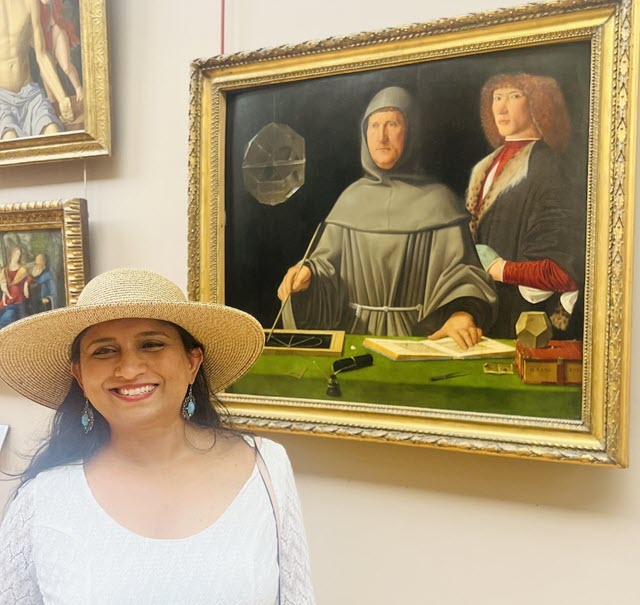- newsletter
- Academic Update

Meeting Luca at the Louvre
Related
Preparing accounting students for professional success
Update on the AICPA Pipeline Acceleration Plan
The importance of accounting program student trips
This summer, I was fortunate to spend a few days in Paris, where I visited the magnificent Louvre Museum, the most-visited museum in the world and one that showcases works dating back nearly 10,000 years. As I stood in what seemed to be a never-ending line to see Leonardo da Vinci’s acclaimed Mona Lisa, my eyes were drawn some distance to a painting of what looked like a teacher engaging with his student. .
I exited the Mona Lisa line to get a closer look. As I approached, I was fascinated to see that it was a portrait of none other than Luca Pacioli, the “father of accounting.” This was an “accounting-meets-art” moment to remember. The painting not only reflected artistic beauty but was also a piece of accounting history. A classic work of art is a gateway to a deeper truth and understanding, The connection to accounting, more so, struck a chord.
From wearing the hat of a traveler, I switched roles to that of an accounting historian, delving deep to unearth the facts of accounting’s Italian roots. I time-travelled into the painting to unravel the origins of accounting and understand the underlying secrets to Pacioli’s prominence and his association with the celebrated genius Leonardo da Vinci.

WHAT THE PAINTING REVEALS
The painting itself is attributed to Italian Renaissance artist Jacopo de’ Barbari (1495). It’s a striking portrait of Luca Pacioli, a brilliant mathematician and monk from the Renaissance period, standing behind a table with mathematical tools that include a compass, chalkboard, pen and protractor. While the identity of the other individual in the painting is a mystery (with multiple attributes unverified), some interpret him as the eternal student instructed by Luca Pacioli, the master teacher.
The Pacioli and Da Vinci connection
Also in the painting is a crystal polyhedron that appears in Pacioli’s book, “The Divine Proportions” and is illustrated by da Vinci himself. Pacioli and da Vinci met in Milan. Not only were they both brilliant minds, but also great friends, drawing from each other’s intellectual genius. Pacioli tutored da Vinci in mathematics and the duo together entertained the Court of Milan with riddles and brainteasers.
The French connection: Why is the painting exhibited at the Louvre?
The Portrait of Luca Pacioli is one of the artistic treasures of Museo Capodimonte in Naples, Italy, but it traveled to the Louvre as part of the exhibition “Naples in Paris.” This exhibition has been attracting art lovers from around the world who want to experience the splendor of Italian masterpieces in the French museum. The Italian paintings are hung with red cords to distinguish them from the French pieces (hung with white cords). The “Naples in Paris” exhibit is on display until Jan 8, 2024. If you plan to visit Paris over the holidays, you can say hello to Luca at the Louvre!
ACCOUNTING’S ANCIENT ORIGINS
My encounter with the Portrait of Luca Pacioli sparked my interest to delve more deeply into the origins of accounting, more specifically the double-entry doctrine. Double-entry bookkeeping was practiced as early as the 1400s by the merchants of Venice, which was a major trade center and business capital due to its strategic location in Europe. The city, like New York City today, was the financial center of the world at that time.
It was in Venice that Pacioli published his “Summa,” the first printed book on the basics of double-entry bookkeeping. The system included the memorandum (a rough draft), journal, and ledger, precursors to the modern-day accounting cycle. Pacioli used the term “deve avere” (must have) when referring to asset accounts, and “deve dare” (must give) when referring to liability accounts.
Debits and credits always have to be in equilibrium. Pacioli is said to have stated in his work: “Don’t go to sleep at night until debits equal credits.” Thus, the ethic of hard work (and long hours) was ingrained in the profession early on, with the underlying goal of balancing the books promptly to ensure accuracy and integrity. The merchants held and traded gold, gems, and exotic spices, and Pacioli discussed the importance of maintaining an inventory listing as the starting point to wealth creation.
ACCOUNTING’S EVOLUTION DOWN THE AGES
After time-traveling to the past and experiencing a piece of accounting history, I was ready to head back to the present. How fascinating to see how accounting’s connection with business goes back in time to a system used by Venetian merchants, which eventually shaped capitalism and the global economy of today. The concept that every debit has a credit and vice versa is the yin/yang that continues to be the Zen of accounting and the backbone of business across the planet.
Even with electronic spreadsheets and online trial balances replacing traditional ledger paper sheets, the basic debits equal credits accounting system will continue in perpetuity. Accounting is now universally accepted as the language of business. With enhancements such as controls and checks to address loopholes, Pacioli’s principles have stood the test of time and changes to civilization.
Madhuri Bandla, CPA, CFE, is a senior lecturer in the department of accounting at the University of North Texas in Denton, Texas




















